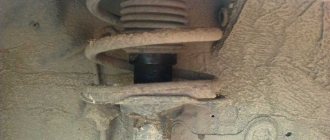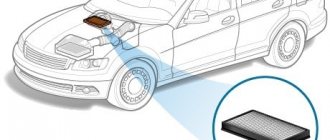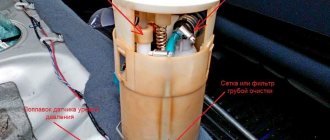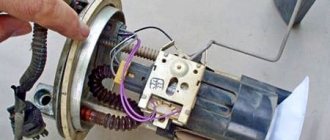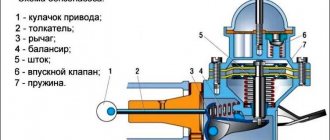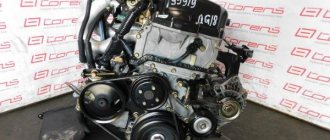The service life of the Almera Classic fuel system depends on the quality of gasoline and mileage. Replacement of the gasoline pump and filter must be done within the prescribed time frame and in the correct sequence. Which filter and pump should I use for replacement, what is the procedure and frequency of maintenance?
How to clean a fuel pump
The fuel tank is the main location of the fuel pump. Its operating principle is that the control unit, immediately after turning off the ignition, forces the gasoline pump to turn on and continue its operation for some time. And this makes it easier to start the engine next time.
The crankshaft position sensor is activated when the engine rotates. The control unit immediately starts the gasoline pump when receiving the signal. But if this signal is not received from the sensor, the gasoline engine, as well as the electric pump, will be stopped. This property increases the battery life. There is a separate relay that helps control the pump in the control unit. If the fuel pump does not turn on, then the first thing to check is the relay.
The uniqueness of Nissan Almera (Nissan Almera) is that the fuel pump has an integrated design, which has a filter designed to clean the fuel. Replacement can only be done together, that is, assembled, since the structure cannot be separated, because it is one-piece.
But this operation is expensive. As a result, we can suggest cleaning the fuel pump on your Nissan. (Although if you still decide to replace the fuel pump, the steps are almost identical to preparing for cleaning).
To clean the fuel pump, you first need to remove it.
Filter functions
Fuel barriers have several tasks:
- Stop large particles of debris and impurities from entering the fuel
- Prevent condensation from entering the system
- The filter will protect the injector elements from damage
When an element wears out, the car shows signs that are difficult to confuse with other breakdowns - a clear loss of engine power both when driving at speed and when starting. Increased gasoline consumption will also confirm the presence of a problem with the fine filter.
When removing the fuel pump, a clear change in the color of the mesh and the presence of a large amount of debris that did not get into the fuel line are detected.
Installing a new fuel barrier (together with a fuel pump) is not an easy procedure and is complicated by the peculiarities of access to the part and the increased fire hazard of the process. Anything that concerns highly flammable substances, such as gasoline, requires special attention when working. The filter itself and the equipment do not need to change quickly if you have the appropriate skills and use professional tools.
Removing the fuel pump
First you need to remove the rear seat element. The gasoline pressure must be relieved in the fuel line. The fuse box, which is located under the dash on the driver's left side, must be open. There is usually a marking on the top (cover) that makes this fuse easy to find as it is labeled FUEL PUMP. It should be in the second column (fourth from the top), and also have the designation 15A. The fuse must be removed from the socket. Start the car, and after 3-5 seconds the engine will stall on its own. This action must be repeated until the engine no longer starts (this usually works after 3-5 attempts). After that, wait a minute and repeat the steps. If everything is done correctly, the pressure will be released almost to the limit, that is, to the end.
If you do not want to find the fuse, you should disconnect the connectors from the flange (located under the seat) of the fuel tank. There is no need to remove the hoses immediately.
You need to remove the filler cap and then relieve the internal pressure in the gas tank. We unscrew the three black plastic bolts and remove the hole cover for inspection. Afterwards, the large plastic nut must be unscrewed by hand. We should be able to see a white glass, where the fuel pump is installed. This is a cylinder measuring 10 by 3 centimeters. Some models have an internal mesh, which is usually yellow with dirt.
Where is the fuel filter located on Nissan Almera Classic?
There is a removable module inside the fuel tank. In addition to the fuel pump and pressure valve, it contains Almera Classic fuel filters. There are two of them, since the car uses a two-level fuel purification algorithm. The lower or coarse filter (mesh) is located in the place from where gasoline enters the fuel intake module. A thin filter is located at the top of the pump housing. It collects the smallest particles of dirt.
Cleaning the pump
Attention! If this procedure does not produce results, then replacing the fuel pump is inevitable.
You should disconnect the fuel hose (it is always rigid), as well as the sensor and do not forget about the float. Then you need to bend the latches (there are 3 of them) of the pump casing. There, below, under the casing, there is a filter.
After cleaning, you need to assemble it all in the opposite order.
Materials used in these operations:
- rags (required quantity);
- small basin;
- a small glass, approximately 300 ml, to collect gasoline flowing from the hose;
- a fire extinguisher is a must (you never know what can happen);
- cleaning products (acetone, liquid intended for washing the injector).
This procedure takes an hour or two on average. Doing the work yourself can save you quite a bit of money, but it will get you a lot dirty.
Tools
If the fuel system is not able to fully perform its functions, this can lead to contamination of its components, which impairs the performance of the vehicle as a whole. It is often impossible to start a car with a clogged gasoline filter. According to experts, most breakdowns in Nissan cars can be prevented by promptly replacing engine oil, filters, transmission fluid and other consumables.
So, you have decided to clean or replace a fuel system component for your Nissan Almera Classic or N16. To do this, you will need to prepare the following materials and tools in advance:
- A lot of rags - keep in mind that some gasoline will spill out of the filter when dismantling it. You need to be careful and, when you take out the filter, immediately remove it from the car and not spill gasoline on the seats, because then dry cleaning the interior will be much more expensive.
- A small container (up to 400 ml) for collecting fuel from the fuel pump hose.
- Fire extinguisher. Situations are different, but when replacing a fuel filter or pump in general, do not forget - you are working with gasoline, so safety is paramount.
- Cleaning agent - either acetone or injector cleaner will do.
- Screwdriver Set.
- Set of wrenches.
Dirty fuel pump
Relays in various versions of Nissan Almera
The fuel pump relay is usually located in the engine compartment; in this case, the marking of this element will be K5. The compartment will be located to the right of the battery, meaning on the passenger side. The lid is held in place with latches that are very easy to snap off. There is one more place where the required element can be located - this is the safety block. It is located next to the driver's right foot. There is a plastic cover that will need to be opened to access the relay. This relay is mainly blue in color.
Replacement
Replacing it is very simple, it is probably the easiest thing in the entire car maintenance list. Although this can be competed with by checking the oil level (which is very simple) or refueling (which is even simpler?).
The following algorithm of actions should be performed:
- First of all, you should open the hood.
- Then open the cover of the relay block (held on by latches (usually three)).
- Find the relay labeled K4. The large relay should be on the bottom left, two smaller ones above it, and what we need will be located on the right side of them.
- Pull out the element. The latches must be snapped off from below in order for the relay to be removed.
- Insert new.
In emergency cases, when you urgently need to drive, and there is no extra relay, you can use a mechanism relay, which you definitely will not need. For example, you can use a fog light relay.
When to change
The condition of the fuel pump must be checked every 15 thousand kilometers, and directly replacing the Nissan Almera fuel filter is done situationally and only together with the fuel pump, as signs of its unsuitability for use are detected.
There are no uniform statistics on the mileage, after which the car will need to be handed over to professional Tech employees. for prevention, install a new fuel pump, with which the filter is also changed.
Depending on the operating mode and the quality of the fuel being poured, the mileage can be up to two hundred km, and in some cases the fuel pump, into which the filter is integrated, will require diagnostics and repairs after a modest 20-30 thousand km.
Basic fuel pump faults
- Filter clogged.
- Sensor malfunctions.
- Failure of the electric motor.
- Damage to the plastic housing.
In accordance with these breakdowns, the fuel pump is repaired on the Nissan Almera H16.
Causes of fuel pump failure
You can extend the life of your fuel pump if you know what affects its operation.
The pump operating time can be reduced by:
- Low quality fuel.
- Driving with an empty tank.
- Interruptions in the car's electrical network.
- Debris getting into the pump.
- Depressurization of the housing.
Signs of a clogged fuel filter
Fine filter
A clogged fuel filter negatively affects the operation of the internal combustion engine, so it is necessary to determine the time to replace it in time. Signs of a clogged gasoline filter:
- Reduced engine traction force. In this case, periodic power failures and its recovery may be observed.
- Unstable engine operation at idle speed.
- Inadequate response of the accelerator pedal, especially when starting the car from a standstill.
- Increased fuel consumption.
- When the transmission is put into neutral at speed, the engine stalls.
- It is difficult to climb uphill because the required speed does not develop.
If the above problems occur, it is recommended to replace the Nissan Almera Classic gasoline filter.
Fine filter
How to remove the fuel pump Nissan Almera
You can remove and replace the fuel pump yourself. On Nissans, as on most modern cars, access to the fuel pump is through a hatch under the rear seat. Owners of, for example, Ford cars are deprived of such luxury.
Work to replace the pump must be carried out away from open flames. Since the work is carried out in the vicinity of a flammable substance, it would be wise to prepare a fire extinguisher in advance.
So, we remove the fuel pump. To do this you need:
- Remove the lower part of the rear seat.
- Remove the fuel pump fuse.
- Start the engine and let it run until it stalls. If desired, the procedure can be repeated - the less fuel left in the pump, the less the risk of getting dirty.
- Remove the filler cap and relieve pressure in the tank.
- Unscrew the bolts and remove the cover under the seat.
- Remove the hoses. Carefully! Fuel will leak from one.
- Disconnect the connector and float.
- Pull out the fuel pump.
Next, depending on your purpose, either replace the fuel pump or disassemble it into its components. The filter is located at the bottom. The manufacturer recommends replacing it together with the pump, but car enthusiasts have experimentally found out that a VAZ “mesh”, for example, from 2112, will fit the Almere.
In addition, you can simply try to clean the filter if its condition is not critical.
Assembly and installation are carried out in reverse order.
When working, it is advisable to stock up on rags so as not to pour gasoline on yourself and the interior of the car.
Which fuel filter should I choose?
The fuel supply complex in Almera Classic provides for the installation of a one-piece module consisting of a fuel pump and a fine and coarse filter element. It is installed directly into the gas tank.
The Almera Classic module can be replaced with an original spare part with article number 1704095F0B or one of the analog versions. These include:
- Kross – KN17-03055;
- Ruei – 2457;
- ASParts - ASP2457.
Coarse filter
Replacing the entire module is expensive. Because of this, Almera Classic owners independently modernize the design, which allows them to change components individually.
As a new gasoline pump, you can use the original Hyundam (art. no. 07040709) or an alternative version of the Bosch gasoline pump from VAZ 2110-2112 (art. no. 0580453453) .
The fine filter is replaced by the following analog components:
- Hyundai/Kia – 319112D000;
- SCT 2.8 – ST399;
- Japanparts 2.2 – FCH22S.
To change the coarse filter in the upgraded Almera Classic gasoline supply complex, you can use:
- KR1111F – Krauf;
- 3109025000 – Hyundai/Kia;
- 1118-1139200 – LADA (for VAZ 2110-2112 models).
Fuel filter hatch
